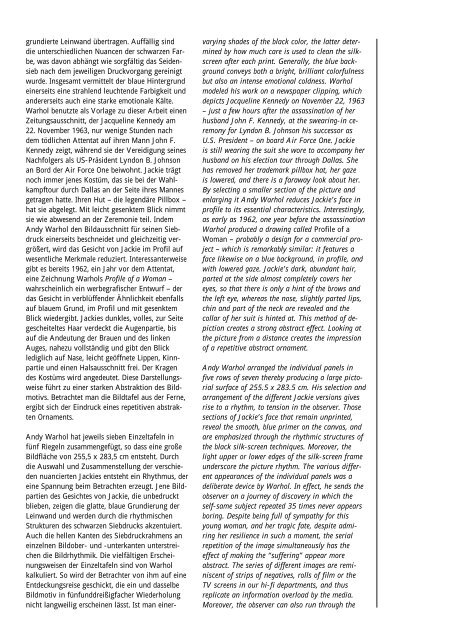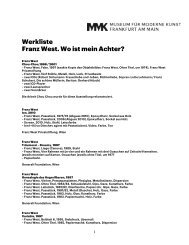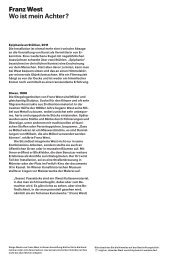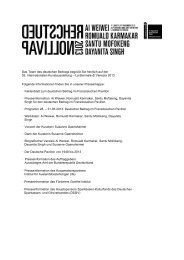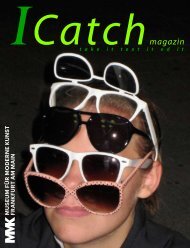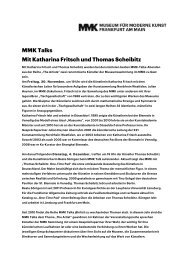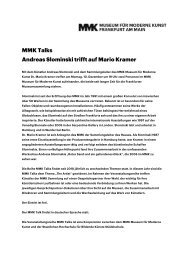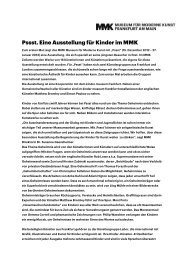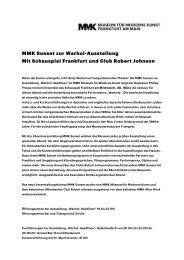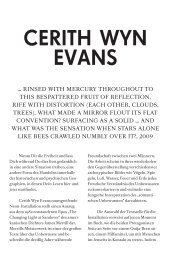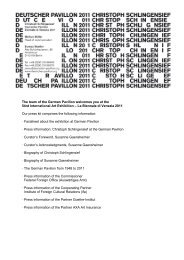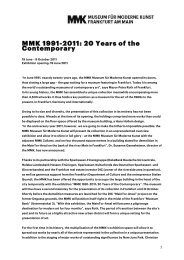Andy Warhol - Museum für Moderne Kunst
Andy Warhol - Museum für Moderne Kunst
Andy Warhol - Museum für Moderne Kunst
Sie wollen auch ein ePaper? Erhöhen Sie die Reichweite Ihrer Titel.
YUMPU macht aus Druck-PDFs automatisch weboptimierte ePaper, die Google liebt.
grundierte Leinwand übertragen. Auffällig sind<br />
die unterschiedlichen Nuancen der schwarzen Farbe,<br />
was davon abhängt wie sorgfältig das Seidensieb<br />
nach dem jeweiligen Druckvorgang gereinigt<br />
wurde. Insgesamt vermittelt der blaue Hintergrund<br />
einerseits eine strahlend leuchtende Farbigkeit und<br />
andererseits auch eine starke emotionale Kälte.<br />
<strong>Warhol</strong> benutzte als Vorlage zu dieser Arbeit einen<br />
Zeitungsausschnitt, der Jacqueline Kennedy am<br />
22. November 1963, nur wenige Stunden nach<br />
dem tödlichen Attentat auf ihren Mann John F.<br />
Kennedy zeigt, während sie der Vereidigung seines<br />
Nachfolgers als US-Präsident Lyndon B. Johnson<br />
an Bord der Air Force One beiwohnt. Jackie trägt<br />
noch immer jenes Kostüm, das sie bei der Wahlkampftour<br />
durch Dallas an der Seite ihres Mannes<br />
getragen hatte. Ihren Hut – die legendäre Pillbox –<br />
hat sie abgelegt. Mit leicht gesenktem Blick nimmt<br />
sie wie abwesend an der Zeremonie teil. Indem<br />
<strong>Andy</strong> <strong>Warhol</strong> den Bildausschnitt <strong>für</strong> seinen Siebdruck<br />
einerseits beschneidet und gleichzeitig vergrößert,<br />
wird das Gesicht von Jackie im Profil auf<br />
wesentliche Merkmale reduziert. Interessanterweise<br />
gibt es bereits 1962, ein Jahr vor dem Attentat,<br />
eine Zeichnung <strong>Warhol</strong>s Profile of a Woman –<br />
wahrscheinlich ein werbegrafischer Entwurf – der<br />
das Gesicht in verblüffender Ähnlichkeit ebenfalls<br />
auf blauem Grund, im Profil und mit gesenktem<br />
Blick wiedergibt. Jackies dunkles, volles, zur Seite<br />
gescheiteltes Haar verdeckt die Augenpartie, bis<br />
auf die Andeutung der Brauen und des linken<br />
Auges, nahezu vollständig und gibt den Blick<br />
lediglich auf Nase, leicht geöffnete Lippen, Kinnpartie<br />
und einen Halsausschnitt frei. Der Kragen<br />
des Kostüms wird angedeutet. Diese Darstellungsweise<br />
führt zu einer starken Abstraktion des Bildmotivs.<br />
Betrachtet man die Bildtafel aus der Ferne,<br />
ergibt sich der Eindruck eines repetitiven abstrakten<br />
Ornaments.<br />
<strong>Andy</strong> <strong>Warhol</strong> hat jeweils sieben Einzeltafeln in<br />
fünf Riegeln zusammengefügt, so dass eine große<br />
Bildfläche von 255,5 x 283,5 cm entsteht. Durch<br />
die Auswahl und Zusammenstellung der verschieden<br />
nuancierten Jackies entsteht ein Rhythmus, der<br />
eine Spannung beim Betrachten erzeugt. Jene Bildpartien<br />
des Gesichtes von Jackie, die unbedruckt<br />
blieben, zeigen die glatte, blaue Grundierung der<br />
Leinwand und werden durch die rhythmischen<br />
Strukturen des schwarzen Siebdrucks akzentuiert.<br />
Auch die hellen Kanten des Siebdruckrahmens an<br />
einzelnen Bildober- und -unterkanten unterstreichen<br />
die Bildrhythmik. Die vielfältigen Erscheinungsweisen<br />
der Einzeltafeln sind von <strong>Warhol</strong><br />
kalkuliert. So wird der Betrachter von ihm auf eine<br />
Entdeckungsreise geschickt, die ein und dasselbe<br />
Bildmotiv in fünfunddreißigfacher Wiederholung<br />
nicht langweilig erscheinen lässt. Ist man einer-<br />
varying shades of the black color, the latter determined<br />
by how much care is used to clean the silkscreen<br />
after each print. Generally, the blue background<br />
conveys both a bright, brilliant colorfulness<br />
but also an intense emotional coldness. <strong>Warhol</strong><br />
modeled his work on a newspaper clipping, which<br />
depicts Jacqueline Kennedy on November 22, 1963<br />
– just a few hours after the assassination of her<br />
husband John F. Kennedy, at the swearing-in ceremony<br />
for Lyndon B. Johnson his successor as<br />
U.S. President – on board Air Force One. Jackie<br />
is still wearing the suit she wore to accompany her<br />
husband on his election tour through Dallas. She<br />
has removed her trademark pillbox hat, her gaze<br />
is lowered, and there is a faraway look about her.<br />
By selecting a smaller section of the picture and<br />
enlarging it <strong>Andy</strong> <strong>Warhol</strong> reduces Jackie’s face in<br />
profile to its essential characteristics. Interestingly,<br />
as early as 1962, one year before the assassination<br />
<strong>Warhol</strong> produced a drawing called Profile of a<br />
Woman – probably a design for a commercial project<br />
– which is remarkably similar: it features a<br />
face likewise on a blue background, in profile, and<br />
with lowered gaze. Jackie’s dark, abundant hair,<br />
parted at the side almost completely covers her<br />
eyes, so that there is only a hint of the brows and<br />
the left eye, whereas the nose, slightly parted lips,<br />
chin and part of the neck are revealed and the<br />
collar of her suit is hinted at. This method of depiction<br />
creates a strong abstract effect. Looking at<br />
the picture from a distance creates the impression<br />
of a repetitive abstract ornament.<br />
<strong>Andy</strong> <strong>Warhol</strong> arranged the individual panels in<br />
five rows of seven thereby producing a large pictorial<br />
surface of 255.5 x 283.5 cm. His selection and<br />
arrangement of the different Jackie versions gives<br />
rise to a rhythm, to tension in the observer. Those<br />
sections of Jackie’s face that remain unprinted,<br />
reveal the smooth, blue primer on the canvas, and<br />
are emphasized through the rhythmic structures of<br />
the black silk-screen techniques. Moreover, the<br />
light upper or lower edges of the silk-screen frame<br />
underscore the picture rhythm. The various different<br />
appearances of the individual panels was a<br />
deliberate device by <strong>Warhol</strong>. In effect, he sends the<br />
observer on a journey of discovery in which the<br />
self-same subject repeated 35 times never appears<br />
boring. Despite being full of sympathy for this<br />
young woman, and her tragic fate, despite admiring<br />
her resilience in such a moment, the serial<br />
repetition of the image simultaneously has the<br />
effect of making the “suffering” appear more<br />
abstract. The series of different images are reminiscent<br />
of strips of negatives, rolls of film or the<br />
TV screens in our hi-fi departments, and thus<br />
replicate an information overload by the media.<br />
Moreover, the observer can also run through the


